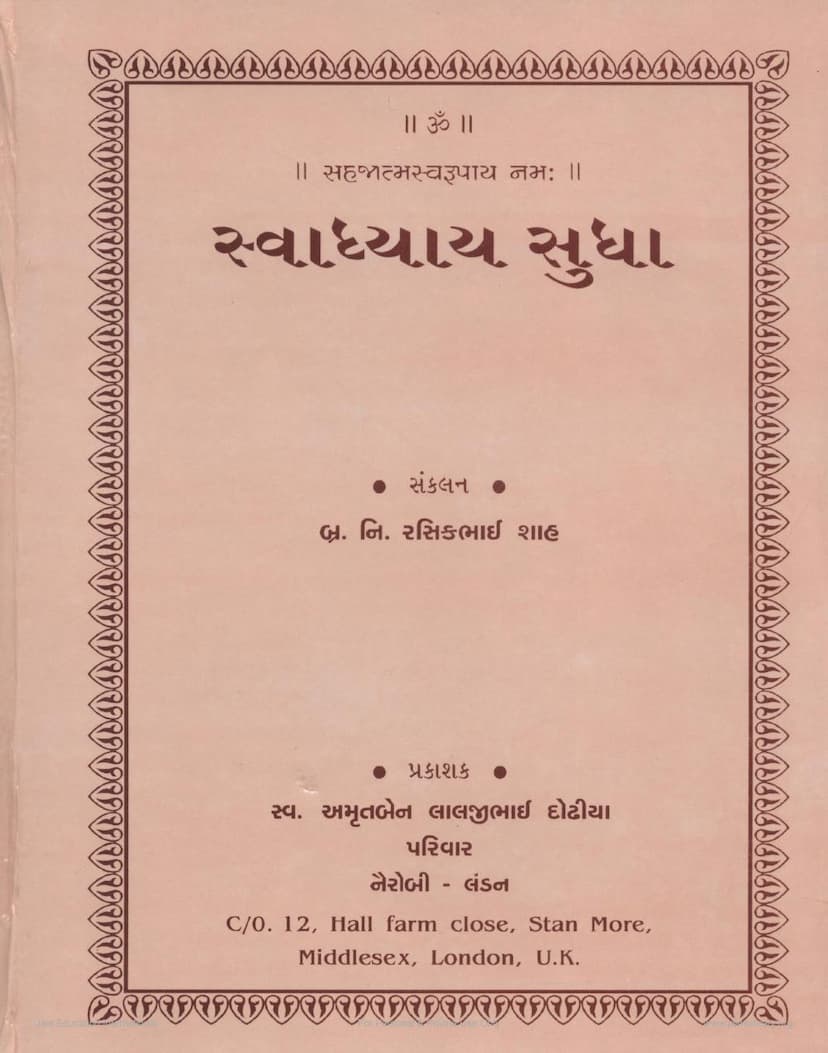Swadhyaya Sudha
Added to library: September 2, 2025

Summary
The Jain text "Swadhyaya Sudha" by Rasikbhai T Shah, published by Raj Saubhag Satsang Mandal Sayla, is a collection of spiritual discourses and explanations aimed at guiding spiritual seekers on their path. The book is dedicated to the lotus feet of the spiritual guide P.P. Gurudev Shri Ladakchand Manekchand Vora.
The content delves into various aspects of Jain philosophy and practice, primarily focusing on the spiritual path, the nature of the soul, the workings of karma, and the means to achieve liberation (moksha).
Key themes and concepts discussed in the text include:
- Nirabadhapanu (Unimpeded State): The text elaborates on achieving an unobstructed state of mind, free from disturbances and fluctuations of thoughts and desires. It explains how to cultivate mental tranquility by detaching from worldly pleasures and controlling the senses.
- Granthibheda (Breaking the Knot): A significant portion of the text is dedicated to understanding "Granthi," which can be interpreted as the deep-seated karmic entanglements or false beliefs that bind the soul. The text explains the process of breaking these knots, which is essential for spiritual progress and moving towards higher states of consciousness (gunasthanas).
- Karma Siddhanta (Theory of Karma): The book provides detailed explanations of the karma theory, including the different types of karmas, their bondage, their effects, and the processes for their shedding (nirjara). It touches upon concepts like the eight types of karmas (Jnanavaraniya, Darshanavaraniya, Vedaniya, Mohaniya, Ayushya, Nama, Gotra, Antaraya) and their various sub-categories.
- Spiritual Stages (Gunasthanas): The text discusses the progressive stages of spiritual development, from the initial stages of ignorance (mithyatva) to the ultimate state of liberation. It explains the obstacles and advancements at each stage, particularly focusing on the importance of Samyak Darshan (right faith) as a crucial turning point.
- The Importance of a Guru: The text repeatedly emphasizes the necessity of a spiritual guide (Guru) for understanding the subtle principles of Jainism and for navigating the path to liberation. The Guru's guidance is presented as essential for overcoming ego and delusion.
- Detachment and Self-Realization: The book stresses the importance of detachment from worldly possessions, relationships, and sensory pleasures to achieve self-realization. It describes the path towards inner peace and the ultimate experience of the soul's true nature.
- The Nature of Reality: The text touches upon the nature of reality, distinguishing between the soul (Jiva) and the non-soul (Ajeeva), and explaining how understanding these distinctions is fundamental to spiritual practice.
- The Seven Principles (Tatvas): While not explicitly detailed in the provided pages, the references to understanding tattvas suggest a comprehensive explanation of the core Jain principles.
- Spiritual Practices: The text alludes to various spiritual practices like meditation (dhyana), contemplation (vicharana), adherence to vows (virati), and the importance of equanimity (samata) in the face of worldly dualities.
- The Concept of 'Yoganuyog' (Coincidence/Opportunity): The text highlights the role of coincidental opportunities and favorable circumstances in spiritual progress, especially in conjunction with right effort (purusharth).
- The Nature of Knowledge: It differentiates between experiential knowledge (anubhav-gamya) and intellectual understanding (buddhi-bal), emphasizing that true spiritual realization comes from direct experience.
- The Ultimate Goal (Moksha): The ultimate aim discussed is the attainment of moksha, a state of eternal peace, bliss, and liberation from the cycle of birth and death, achieved through the eradication of karma and the realization of the soul's pure nature.
The text is presented in a devotional and instructive manner, encouraging readers to reflect on these teachings and apply them in their spiritual journey. The repeated emphasis on spiritual effort, self-awareness, and devotion to the teachings of the Jinas and their guides underscores the practical aspect of the spiritual path outlined in "Swadhyaya Sudha." The familial dedications and acknowledgments suggest a community-oriented approach to spreading spiritual knowledge.